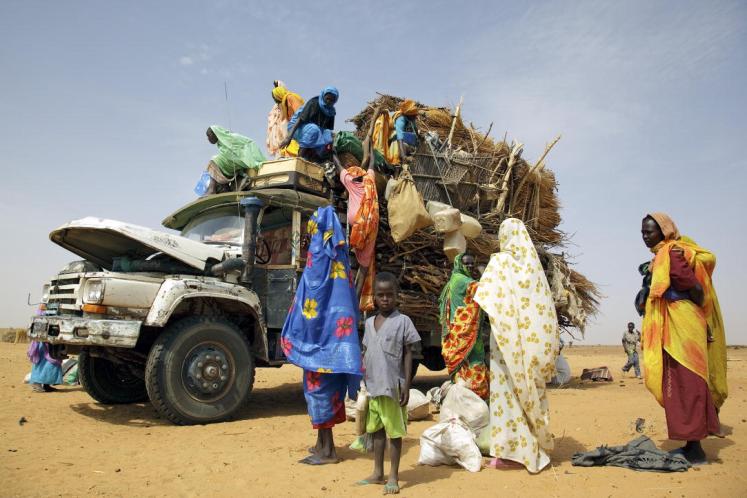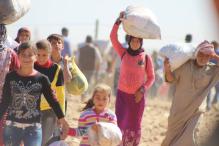The international humanitarian system, unable to meet the immense needs created by new crises and unable to disengage from chronic emergencies, is on the brink of failure. Six figures highlight the need for significant change:
-
446%: The increase in the size of the global humanitarian appeal between 2004 and 2013 – from $3billion to $16.4 billion.
-
51.2 million: The number of displaced people at the end of 2013 – more than at any point since World War II.
-
2.1 million: The number of newly displaced people in Iraq alone, since 1 January 2014.
-
20 years: The average length of displacement in major refugee situations.
-
90%: The proportion of appeals that continue for more than 3 years.
-
78%: The portion of spending from OECD DAC donors that are allocated to protracted emergencies.
The numbers go on. 60% of appeals have continued for more than eight years. The Democratic Republic of Congo, Sudan, Afghanistan and Somalia, which represent 27% of humanitarian funding over the last 4 years, have been on the appeals roster since its inception in 1992. UNICEF estimates that there are 3.8 million displaced children in Syria.
The origins of the humanitarian system’s crisis are complex. Natural disaster and conflict are affecting an increasing number of people. More actors are delivering more types of assistance in emergencies than ever before, and while they share a common purpose, they often share little else. Many new actors are exclusively local; many have risen from countries that have seen significant economic growth over the last decade and have become increasingly international. The expectations of people affected by crises have also changed – they now demand information as quickly as they demand shelter.
The simple problem is this: The humanitarian system cannot both rapidly respond to new crises, and continue to service situations of chronic need.
This problem has been widely recognized. Since the early 1990s, there have been countless efforts to strengthen the ability of development actors to take over at the end of the emergency phase of a crisis, to free up capacities for the next emergency. Similarly, there have been a number of efforts to translate the idea of resilience into practice – which in theory would reduce the humanitarian caseload. Yet the fundamental problem remains as true today as it was a decade ago. And as long as a sudden-onset natural disaster and a slow-onset, long-duration crisis are met by the same response, this will continue to remain true.
The demand for change
Building an international system that can both respond to emergencies and deliver in the aftermath of conflict and protracted crises seems simple. It requires an understanding of the differing needs of emergency response and of conflict. It requires making adequate resources – human and financial – simultaneously available for both emergency response and longer-term rebuilding. It requires building a response that can be anchored in people and local communities, rather than in the international system. Yet this represents a significant shift from where the system is today.
We propose three basic principles that could help transform humanitarian assistance:
-
Be honest about the limits of humanitarian response, and be willing to say “no” when humanitarian assistance is simply the wrong vehicle.
-
Recognize the predictable long-term consequences of emergencies, and adapt assistance to address these consequences using the right time-frames.
-
Recognize the negative effects of some short-term assistance, and prioritize methods that better support local markets and institutions.
These principles can be linked to three concrete objectives to become more than just rhetoric:
-
Multi-year, risk-tolerant resources that can enable investment in resilience, innovative approaches and experiential learning.
-
Integrated strategies that take a longer-term approach to meeting the needs of communities and people, including:
-
Durable solutions for displacement that recognize it is not a short-term phenomenon.
-
Recognition, within each sector, of how short-term efforts can support local and national institutions in building resilience.
-
-
Joint analysis spanning the risks and needs faced by communities and people.
Bridging the humanitarian/development divide
Ultimately, there needs to be an agreement between the World Bank, the Regional Development Banks, and the United Nations to translate these principles into actions, and set in motion the steps necessary to reach these objectives. Such an agreement should consider the following:
A: Be honest about the limits of humanitarian response and secure multi-year, risk tolerant resources for resilience.
To institutionalise this principle, resources that respond to sudden-onset disasters need to be separated from the resources that respond to slow-onset crises, including conflict. This does not mean the absence of overlap; rather it requires staffing and resourcing these activities differently because they are fundamentally different in nature. Options might include a combination of:
-
Placing a strict time-limit on humanitarian response – defining it as “emergency assistance” which is provided for a period of less than 180 days, in order to address acute needs.
-
Removing the label ‘humanitarian’ from funding sources, and assigning time horizons/sunset clauses to funding for emergency response.
-
Creation of a joint WB/UN standing resource, or extension of the terms of reference of an existing resource such as the Central Emergency Response Fund (CERF) or the Peacebuilding Fund (PBF), to enable multi-year resilience programming (i) in response to chronic indicators, such as the grim Global Acute Malnutrition figures for the Sahel; (ii) in response to a conflict; or (iii) to flow after a specified time-period (e.g. 180 days) for a sudden-onset disaster.
Essentially there is a need for an accelerated flow of funding to support resilience and institutional capacity building in conflict-affected contexts. At the same time they need to increase the risk-tolerance of such funding arrangements to recognize that these are often extreme situations, and traditional development operations simply do not work (e.g. in Afghanistan, where much of the country has limited accessibility). This could be rapidly rolled out in a number of countries, where there are existing multi-year appeals. Such a funding mechanism could simply take over.
B. Recognize the predictable long-term consequences of emergencies and use integrated strategies that take a longer-term approach.
To institutionalise this principle, there is a need to change the way that planning occurs in response to conflict, or a slow-onset emergency. This refers to both the overall planning process across a country or region, as well as sector-specific plans.
Simply put, planning cycles must bridge emergency response and development. One option, drawing on both military and corporate planning models, is to mandate a tiered planning cycle. This could entail an initial response plan with a strict time limit (e.g. 180 days), with a medium-term time-frame for the follow-on plan (e.g. 2 years), followed by a long-term time-frame for any subsequent plan for international assistance (e.g. 5 years). Each plan should still have to articulate distinct near-term, medium-term and long-term goals, and the contributions of interventions to resilience through these goals. These planning cycles will also need to build in processes to secure the safe exit of humanitarian programmes. Social safety net programmes, delivered through a blend of traditional humanitarian actors and development partners, which explicitly target humanitarian indicators could be launched in a select number of countries.
At the sector level, there is an urgent need for work to identify how short-term efforts can support communities and local/national institutions in building resilience. It will need to explore how this works with respect to basic services, such as education and water and sanitation, where there is a strong natural link to longer-term programming. This work must also address the challenge of durable solutions for displacement in some substantial measure, as this is a primary cause of the crisis overwhelming the current system.
C. Recognize the negative effects of some short-term assistance, instead using joint analysis spanning risks and needs.
The old saw that every crisis is an opportunity is critical to improving long-term responses to crises. Unfortunately, the history of emergency response also suggests that every crisis contains the opportunity to make things worse. In order to rebuild better, analysis has to understand risks, needs, and opportunities. In order to deliver effective assistance, interventions have to recognize that they can cause as well as solve problems. The most well-known example is how the provision of food has been known to undermine local food production and create dependence. New examples keep cropping up – including a recent series of reports that highlight how malaria nets are threatening fish stocks. The political complexity of post-conflict contexts, in particular, requires much more political economy analysis to ensure that interventions do not simply strengthen the control of warlords and political spoilers. This is no simple task – in such situations, understanding how to balance humanitarian imperatives with the reality that a stable political outcome is the only resilient solution, is difficult.
Strong provisions that mandate careful analysis that span humanitarian and development actors, and also link carefully to peacebuilding, political action, and peacekeeping operations are absolutely necessary.
Improving response beyond these actors
Bridging the development/humanitarian divide is not a panacea. The measures above would help improve response, but will not address a number of structural issues that linger – as a result of the humanitarian system, as it stands, simply not being appropriate for the world in which we now live.
First, the problem of middle-men remains critical. There are simply too many layers involved in the transfer of funds from those with money to those with needs. This is discussed in humanitarian (and peacebuilding) circles as a problem of risk management. But risk management tools will not solve this – there is a need for a more clear and honest relationship with taxpayers and parliaments in donor countries, to explain why risks need to be taken, and what those risks really entail – as well as the cost of not changing the way we do business.
Second, and linked to all of the above, is the tenuous claim by the United Nations and international NGO’s for a comparative advantage which may not be real. It is simply not clear how many lives are saved by rapid international response. The resources used to maintain standing global capacities for rapid response could arguably be better invested in localised capacity building and disaster-risk reduction. A hard look at these numbers is needed.
Finally, and perhaps most importantly, there remains a profound disconnect between the people who manage humanitarian assistance, and the people it is supposed to help. Suggestions for remedies seem more focused on marginal changes to communications, than on fundamental transformations of the way resources are allocated, and power is held. This is inadequate.
Building a system that is capable of supporting resilience does not require letting go of the virtues of an emergency response system, which should be: (i) geared for short-term response, in terms of funding, planning, and programming; (ii) skilled for the kind of life-saving assistance that emergency response requires; and (iii) continually evolving to embrace new actors.
But in trying to respond to the short and the long-term, to deliver both resilience and emergency response, we have built a system that does neither as well as it should. And that is not just a poor use of limited resources; it is a betrayal of people in need.
Suggested citation: Rahul Chandran., "It's Broke, So Fix It: Humanitarian Response in Crisis," UNU-CPR (blog), 2015-03-09, https://unu.edu/cpr/blog-post/its-broke-so-fix-it-humanitarian-response-crisis.



